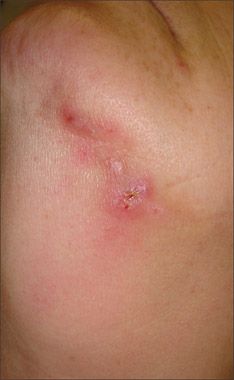Cutaneous Dental Sinus Tract
For more than a year, a 65-year-old woman had a nonpainful but nonhealing erythematous papule in the left submandibular area. She denied any unusual exposures or work history. Her most recent dental examination was several years earlier.

For more than a year, a 65-year-old woman had a nonpainful but nonhealing erythematous papule in the left submandibular area. She denied any unusual exposures or work history. Her most recent dental examination was several years earlier.
The papule measured 2 × 1 cm and had suppuration with surrounding skin erythema but no telangiectasias. This was presumed to be a dental sinus tract lesion; the diagnosis was confirmed by the patient's dentist with examination and radiography.
Cutaneous dental sinus tracts are uncommon and can be missed, which can lead to unnecessary surgical procedures and antibiotic therapy.1 The tract usually results from an apical abscess that forms because of dental caries that cause periapical inflammation and suppuration. Cutaneous sinus tracts are associated with mandibular teeth in 80% of patients and with maxillary teeth in 20%.2 They typically exit onto the chin or lower jaw and can also be found in the cheek, perinasal, or neck regions.
In acute cases, patients generally present to the dentist with pain and swelling. In contrast, chronic cutaneous sinus tracts are usually asymptomatic.3 There is no pain because the tract acts as an outlet for discharge from the infected tooth. Patients will see their primary care provider because of the cutaneous manifestation of the tract and not its underlying cause. A dental cause is important to consider with chronic suppurative lesions on the head and neck.
Biopsy is not indicated in all cases. Histological findings demonstrate either granulation tissue or connective tissue with inflammatory cells. Intraoral radiographs are necessary to diagnose the underlying cause; a carious tooth or periapical radiolucency suggests a dental source of infection.2
Treatment consists of a root canal or extraction of the affected tooth.4 A tooth that has significant tissue damage and is nonrestorable should be extracted. Otherwise, a root canal is the preferred treatment. After the extraction or root canal surgery, healing of the face or neck lesion and tract occurs within 5 to 14 days.1 The area usually heals with a slight dimpling and hyperpigmentation. This patient was treated with extraction of the tooth with excellent results.
References:
REFERENCES:
1.
Johnson BR, Remeikis NA, Van Cura JE. Diagnosis and treatment of cutaneous facial sinus tracts of dental origin.
J Am Dental Assoc
. 1999;130:832-836.
2.
Barrowman, RA, Rahimi M, Evans MD, et al. Cutaneous sinus tracts of dental origin.
Med J Aust
. 2007;186:264-265.
3.
Lewin-Epstein J, Taicher S, Azaz B. Cutaneous sinus tracts of dental origin.
Arch Dermatol
. 1978;114:1158-1161.
4.
Cioffi, GA, Terezhalmy GT, Parlette HL. Cutaneous draining sinus tract: an odontogenic etiology.
J Am Acad Dermatol
. 1986;14:94-100.